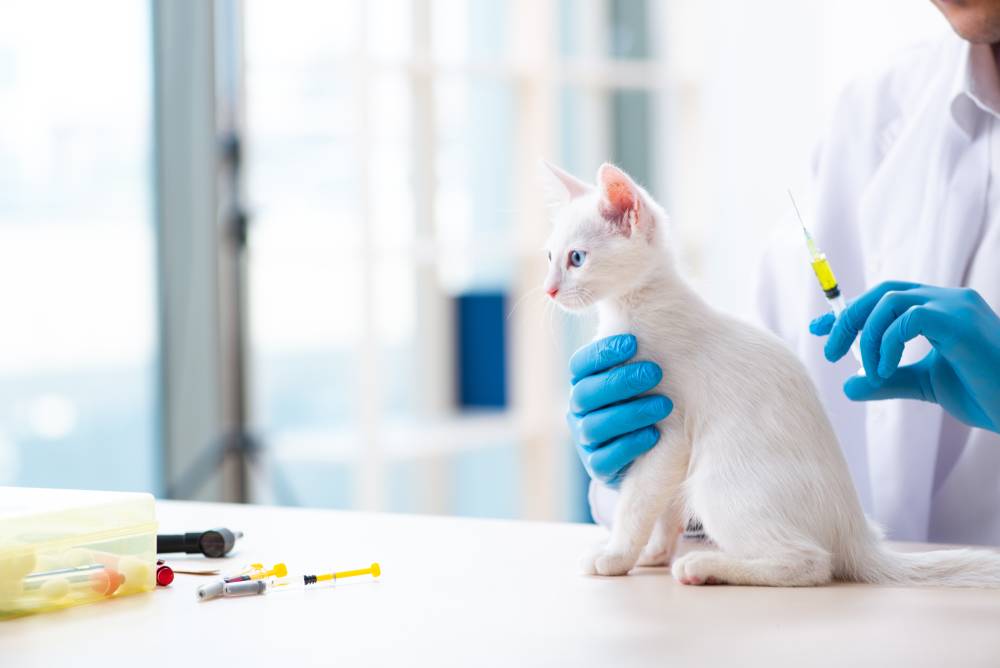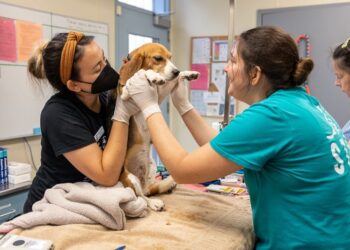Being a responsible pet owner is a deeply rewarding job, but it comes with a major, non-negotiable duty: protecting your furry family member from preventable diseases.
In the modern world, infectious illnesses and parasites are not just historical nightmares; they are constant, lurking threats.
Thankfully, we have powerful tools—vaccinations and preventive medicine—that act as an invisible suit of armor for your pet.
This guide is your comprehensive blueprint for understanding why these protocols are essential, how they work, and what specific steps you need to take to ensure your dog or cat lives a long, healthy, and happy life, free from easily avoidable suffering.
The Power of the Poke—Understanding Vaccinations

Vaccines are truly one of the greatest advancements in veterinary science. They work by introducing tiny, harmless versions of disease-causing organisms (antigens) to your pet’s body.
This process gently teaches the immune system how to recognize and fight off the real, dangerous pathogens, creating a state of long-lasting immunity.
The Core vs. Non-Core Distinction
Not every pet needs every single vaccine. Veterinarians wisely divide vaccines into two groups based on the severity of the disease and the likelihood of exposure.
A. Core Vaccines: The Essential Protection
These vaccines are considered mandatory for virtually all dogs and cats, regardless of their lifestyle or location, because the diseases they prevent are widespread, highly contagious, and often fatal.
For Dogs (Canine):
- A. Canine Parvovirus (CPV): A highly contagious virus that causes severe, bloody vomiting and diarrhea, leading to extreme dehydration and death, especially in puppies.
- B. Canine Distemper Virus (CDV): A severe systemic disease that affects the respiratory, gastrointestinal, and nervous systems, often causing seizures and lifelong neurological damage.
- C. Canine Adenovirus (CAV) / Hepatitis: Protects against two types of Adenovirus, one of which causes infectious canine hepatitis, a serious disease targeting the liver.
- D. Rabies: A fatal viral disease that attacks the central nervous system and is zoonotic (transmissible to humans). Vaccination is legally required in most jurisdictions worldwide.
For Cats (Feline):
- A. Feline Panleukopenia (FPV) / Feline Distemper: A highly contagious, life-threatening viral disease causing severe vomiting, diarrhea, and a critical drop in white blood cell count.
- B. Feline Herpesvirus-1 (FHV-1) / Rhinotracheitis: A major cause of severe upper respiratory infection, sneezing, and eye issues.
- C. Feline Calicivirus (FCV): Another common cause of upper respiratory illness, often resulting in oral ulcers and lameness.
- D. Rabies: Mandatory in most regions, protecting against this fatal, zoonotic neurological disease.
B. Non-Core Vaccines: Lifestyle-Dependent Shields
These are recommended only for pets whose lifestyle, geographic location, or environment puts them at a higher risk of exposure. Your veterinarian is the best person to assess this risk.
Common Non-Core Dog Vaccines:
- A. Bordetella bronchiseptica (Kennel Cough): Recommended for dogs who socialize frequently, attend daycare, go to the groomer, or are boarded. It is a highly contagious respiratory infection.
- B. Leptospirosis: A bacterial disease spread through the urine of wildlife (e.g., raccoons, rats) and found in stagnant water. Recommended for pets who swim, hike, or live near rural areas.
- C. Lyme Disease: Transmitted by ticks; recommended for dogs living in or traveling to tick-heavy regions.
- D. Canine Influenza (Dog Flu): Recommended for social dogs or those who travel between regions.
Common Non-Core Cat Vaccines:
- A. Feline Leukemia Virus (FeLV): A serious, immunosuppressive, and often fatal disease. Highly recommended for all kittens and adult cats who spend time outdoors or live with an FeLV-positive cat.
- B. Chlamydophila felis: A bacterial agent that causes conjunctivitis; sometimes recommended for cats in multi-cat households or shelters.
Navigating the Puppy and Kitten Schedule
Vaccinating a young pet is a crucial, multi-step process. Puppies and kittens receive initial immunity from their mothers’ milk, called Maternal Derived Antibodies (MDA).
While protective, these MDA can actually neutralize vaccines. The challenge is that no one knows exactly when the MDA wears off. Therefore, a series of vaccinations is given to ensure the pet develops immunity the moment the MDA protection fades.
The Critical Series (Approximate Schedule):
| Age | Puppy Focus (Core) | Kitten Focus (Core & FeLV) |
| 6-8 Weeks | Distemper/Parvo (DHPP first dose) | FVRCP first dose |
| 9-12 Weeks | DHPP booster + Non-Core (e.g., Lepto/Bordetella) | FVRCP booster + FeLV first dose |
| 14-16 Weeks | DHPP final booster + Rabies (First dose) | FVRCP final booster + FeLV booster + Rabies (First dose) |
| 6 Months/1 Year | Rabies booster (depending on local law) | Rabies booster (depending on local law) |
- The 16-Week Rule: The last vaccine in the initial series (DHPP/FVRCP) is critical. It should be given no earlier than 16 weeks of age to ensure immunity develops after any interference from the mother’s antibodies is gone.
- Adult Boosters: After the initial puppy/kitten series, most core vaccines (except Rabies) are typically boosted one year later, and then every three years thereafter. Rabies frequency is dictated by local law and the vaccine manufacturer (usually one year, then every three years).
The Year-Round War on Parasites
While vaccines protect against viruses and bacteria, they do nothing against the internal and external parasites that constantly threaten your pet.
Parasite prevention is an all-year, non-negotiable commitment because these pests don’t just cause discomfort; they transmit life-threatening diseases.
A. The External Threat: Fleas and Ticks
These pests are bloodsuckers that cause intense itching, skin infections, and, most dangerously, transmit serious diseases.
I. Fleas: The Household Invaders
Fleas reproduce rapidly, with a single flea laying up to 50 eggs per day. These eggs fall off the pet and into the environment (carpets, bedding, furniture), leading to massive household infestations.
- Disease Risk: Fleas can transmit Tapeworms (ingested during grooming) and cause Flea Allergy Dermatitis (FAD), a condition where the pet is highly allergic to flea saliva, resulting in severe itching and hair loss from just one bite.
II. Ticks: The Disease Vectors
Ticks transmit pathogens during the blood-feeding process. They are prevalent in tall grasses, wooded areas, and even suburban gardens.
- Disease Risk: Ticks are responsible for spreading highly serious, systemic illnesses like Lyme disease, Ehrlichiosis, and Anaplasmosis—all of which can cause fever, joint pain, lameness, and severe long-term organ damage.
B. The Internal Threat: Worms and Heartworm
Internal parasites, often called worms, steal nutrients from your pet, leading to weight loss, vomiting, and diarrhea.
I. Intestinal Worms (Roundworms, Hookworms, Whipworms, Tapeworms)
- Transmission: Pets are infected by ingesting eggs from contaminated soil or feces, by eating infected prey (like rodents), or even through the mother’s placenta or milk (Roundworms/Hookworms).
- Zoonotic Risk: Roundworms and Hookworms are a major zoonotic risk, meaning they can infect humans, particularly children, leading to serious health issues like visceral larval migrans (where the larvae migrate through human organs). This is a primary reason for routine deworming and parasite control.
II. Heartworm (Dirofilaria immitis)
This is perhaps the most devastating parasite, requiring an entirely separate type of prevention.
- Transmission: Heartworms are spread solely through the bite of an infected mosquito.
- The Disease: The larvae mature into worms that reside in the heart, lungs, and associated blood vessels, causing severe damage, heart failure, respiratory distress, and ultimately death if left untreated. Treatment is extremely difficult, costly, and risky for the dog.
C. Prevention Strategies
The most effective approach is a Year-Round, Multi-Modal Strategy using veterinarian-recommended products.
- A. Oral Medications: Chewable tablets (e.g., isoxazoline class like Bravecto or NexGard) are extremely popular, offering systemic protection against fleas and ticks for 1-3 months. Many combination products also include heartworm and intestinal worm prevention.
- B. Topical Spot-Ons: Liquid products applied to the skin between the shoulder blades, spreading over the body to repel and kill parasites (e.g., Advantage, Frontline).
- C. Collars: Certain slow-release collars (e.g., Seresto) can offer long-term protection (up to 8 months) against both fleas and ticks.
- D. Heartworm Preventives: These are generally given monthly, year-round. They work by killing the heartworm larvae transmitted by mosquitoes before they can mature. This must be done year-round, even in cold climates, and requires an annual heartworm test.
- E. Deworming: Routine deworming against intestinal parasites is often administered several times during puppy/kittenhood and then regularly throughout the adult life, often incorporated into the heartworm preventive.
Addressing Common Concerns and Side Effects

Some pet owners express understandable concern about the safety and necessity of frequent vaccinations or the use of chemical preventives. It’s important to address these concerns with balance and fact.
A. Vaccination Side Effects
The vast majority of pets experience no adverse reaction. When they do, side effects are usually mild and temporary:
- A. Mild Symptoms: Slight fever, lethargy (tiredness), or reduced appetite lasting 24-48 hours.
- B. Localized Reaction: Mild swelling or tenderness at the injection site.
- C. Allergic Reaction (Rare): Hives, facial swelling, vomiting, diarrhea, or collapse. This is an emergency and requires immediate veterinary attention.
- D. Injection Site Sarcoma (Extremely Rare in Cats): A type of aggressive tumor linked to inflammation at the injection site. Protocols have been adjusted (e.g., using non-adjuvanted FeLV and Rabies vaccines) and the risk of contracting and dying from a core disease far outweighs the minimal risk of this tumor.
B. The Myth of Over-Vaccination
Veterinary guidelines have shifted significantly in recent decades. We now generally follow a titer-based approach or three-year protocols for core adult vaccines, moving away from annual boosters for every single illness.
- Titer Testing
This blood test measures the level of antibodies (protection) a pet currently has against certain diseases (like Distemper and Parvo).
If the titer is high enough, a vaccine booster may be delayed, ensuring your pet is only vaccinated when truly necessary. This is a great tool for owners concerned about potential side effects.
C. Holistic vs. Conventional Prevention
While the desire for “natural” or “holistic” parasite prevention is strong, it is crucial to understand that many anecdotal or herbal remedies (e.g., garlic, essential oils, amber collars) have no proven efficacy against life-threatening parasites like ticks and heartworms.
Relying on them can leave your pet dangerously vulnerable to fatal diseases. Always prioritize veterinarian-backed, rigorously tested preventives.
Conclusion
The path to maximizing your pet’s health and longevity is paved with prevention, and the dual pillars of vaccinationand year-round parasite control are your most effective tools.
We have seen how core vaccines are foundational, protecting against globally distributed, fatal diseases like Rabies and Parvovirus, while non-core vaccines allow you to tailor your pet’s defense based on their unique environment and social life.
Getting the timing right, especially during the critical puppy and kitten series, ensures they transition smoothly from maternal immunity to their own lasting protection.
Beyond the initial shots, the work shifts to maintaining that protective barrier against the ceaseless threat of parasites.
Fleas and ticks are more than mere annoyances; they are active disease vectors, responsible for spreading debilitating illnesses like Lyme disease and FAD.
Internally, the invisible danger of intestinal worms carries a significant zoonotic risk to human families, making routine deworming a public health measure.
And the gravest internal threat, Heartworm, transmitted by the humble mosquito, requires unwavering, year-round preventive medication because the cure is so dangerous and expensive.
Your commitment to following the recommended vaccination schedules—understanding the shift from annual boosters to modern three-year protocols or titer testing—demonstrates a deep level of responsible ownership.
Furthermore, your diligence in administering prescription-grade, year-round parasite preventives is the defining choice that shields your pet from needless suffering and death.
By working closely with your veterinarian to establish a tailored health shield—one that balances effective protection with minimal risk—you are ensuring your companion’s coat stays glossy, their heart stays healthy, and their golden years are filled with joy, not illness.
A proactive, preventive approach isn’t just a choice; it’s a promise of a full, protected life for the friend who gives you their unconditional love.







